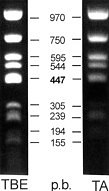

DNA marker 155-970
Estimation of the size of DNA fragments generated in PCR (PCR fragments) or by DNA cutting by restriction enzymes (restriction fragments) is usually based on comparison of these fragments with DNA fragments of known size (DNA markers). Size of PCR fragments is often in the range 150-1000 base pairs. This range is covered by DNA fragments, which are part of DNA marker 155-970 (Fig. 1). These fragments were produced by cutting a reference plasmid by restriction enzyme.
| Cat.no. | Name | Package | Price | |
|---|---|---|---|---|
| D060 | DNA marker 155-970 | 50 µg/250 µl | 800,00 Kč | |
| D062 | DNA marker 155-970 | 5x 50 µg/250 µl | 2 800,00 Kč |
Product description
Estimation of the size of DNA fragments generated in PCR (PCR fragments) or by DNA cutting by restriction enzymes (restriction fragments) is usually based on comparison of these fragments with DNA fragments of known size (DNA markers). Size of PCR fragments is often in the range 150-1000 base pairs. This range is covered by DNA fragments, which are part of DNA marker 155-970 (Fig. 1). These fragments were produced by cutting a reference plasmid by restriction enzyme.
Technical data
Concentration
- 1 µg DNA/5 µl buffer (25 mM potassium acetate, 10mM Tris acetate and 25 mM EDTA).
Packaging
- 1 tube containing 50 µg of restriction DNA fragments in 250 µl of buffer. This amount enables ~60 analyses (0.8 µg DNA/marker).
Storage
- Store at temperature -20 ± 4oC. Material can be repeatedly defrosted.
Quality control
- The presence of corresponding fragments is controlled by electrophoresis in agarose gel supplemented with ethidium bromide (1 µg/ml). When observed under UV light, 9 DNA fragments are observed (155, 194, 239, 305, 447,544,595,750, and 970 bp) as shown in Fig. 1.

Fig. 1. Electrophoretic separation of components of DNA marker 155-970.
4 µl of DNA marker was mixed with 6 µl of PCR H2O and 2 µl of PCR loading buffer. Fragments were separated in 1.2% agarose gel, which contained ethidium bromide (1µg/ml) and 1x TBE or TA buffer. The numbers represent the number of base pairs in the corresponding DNA fragments.